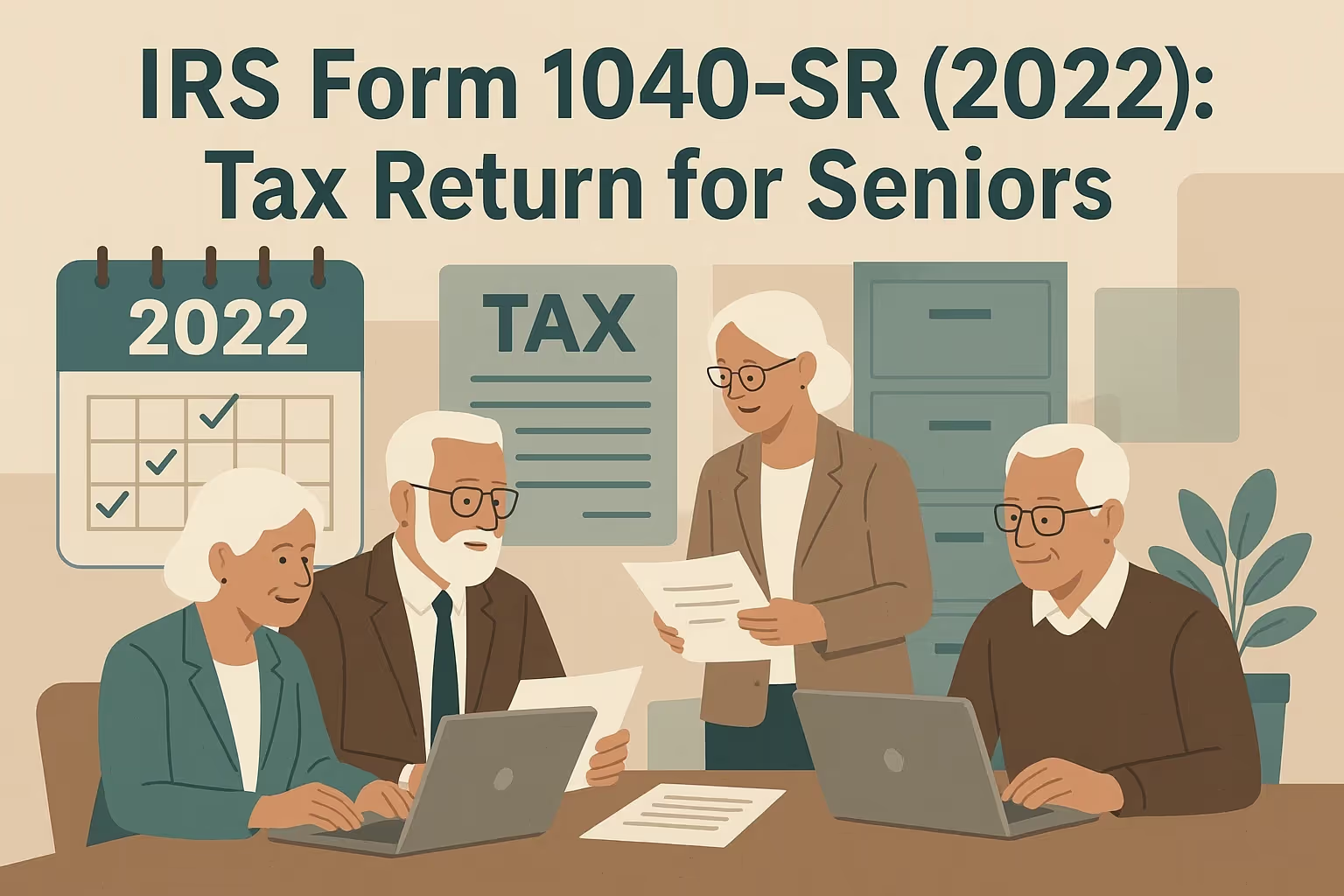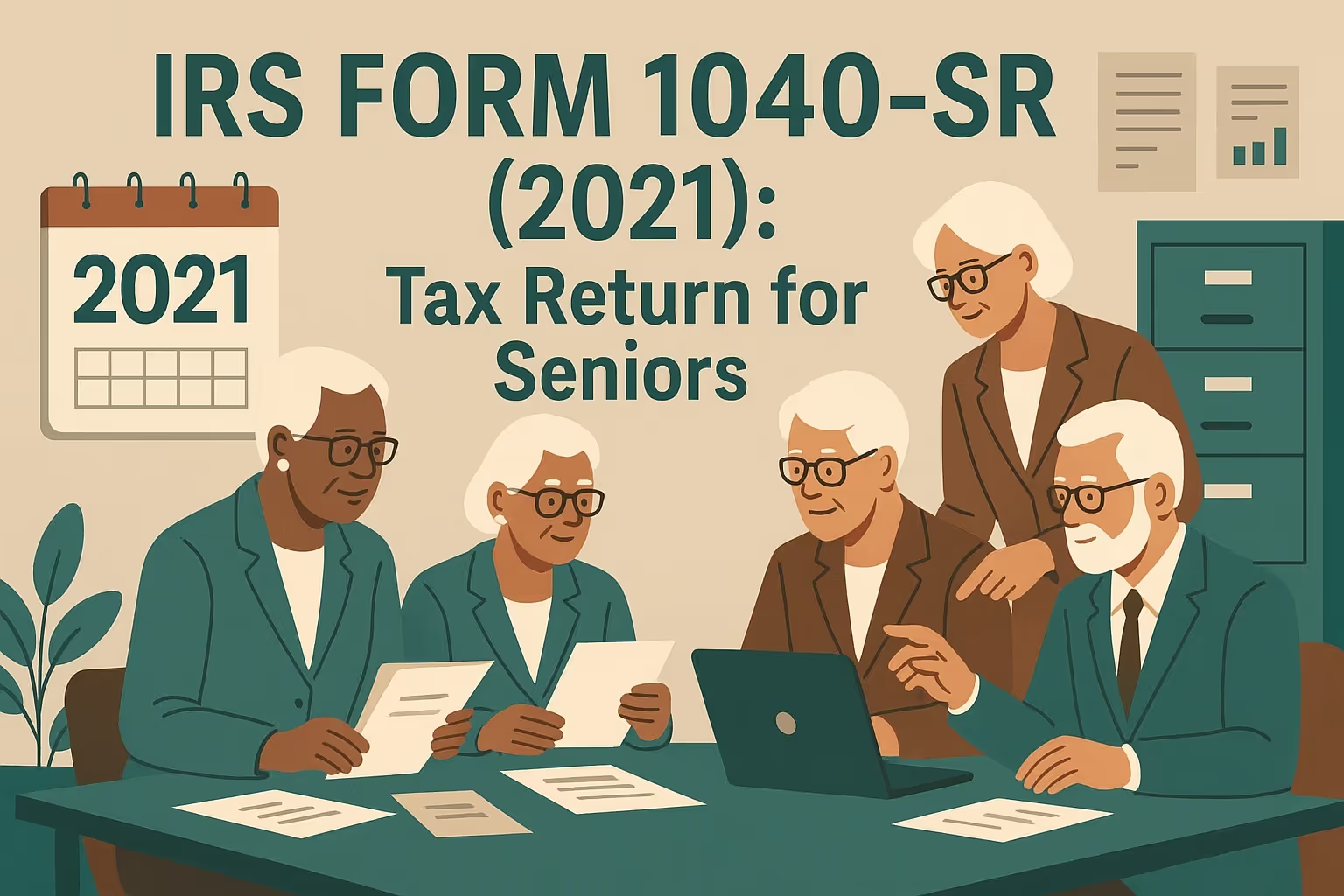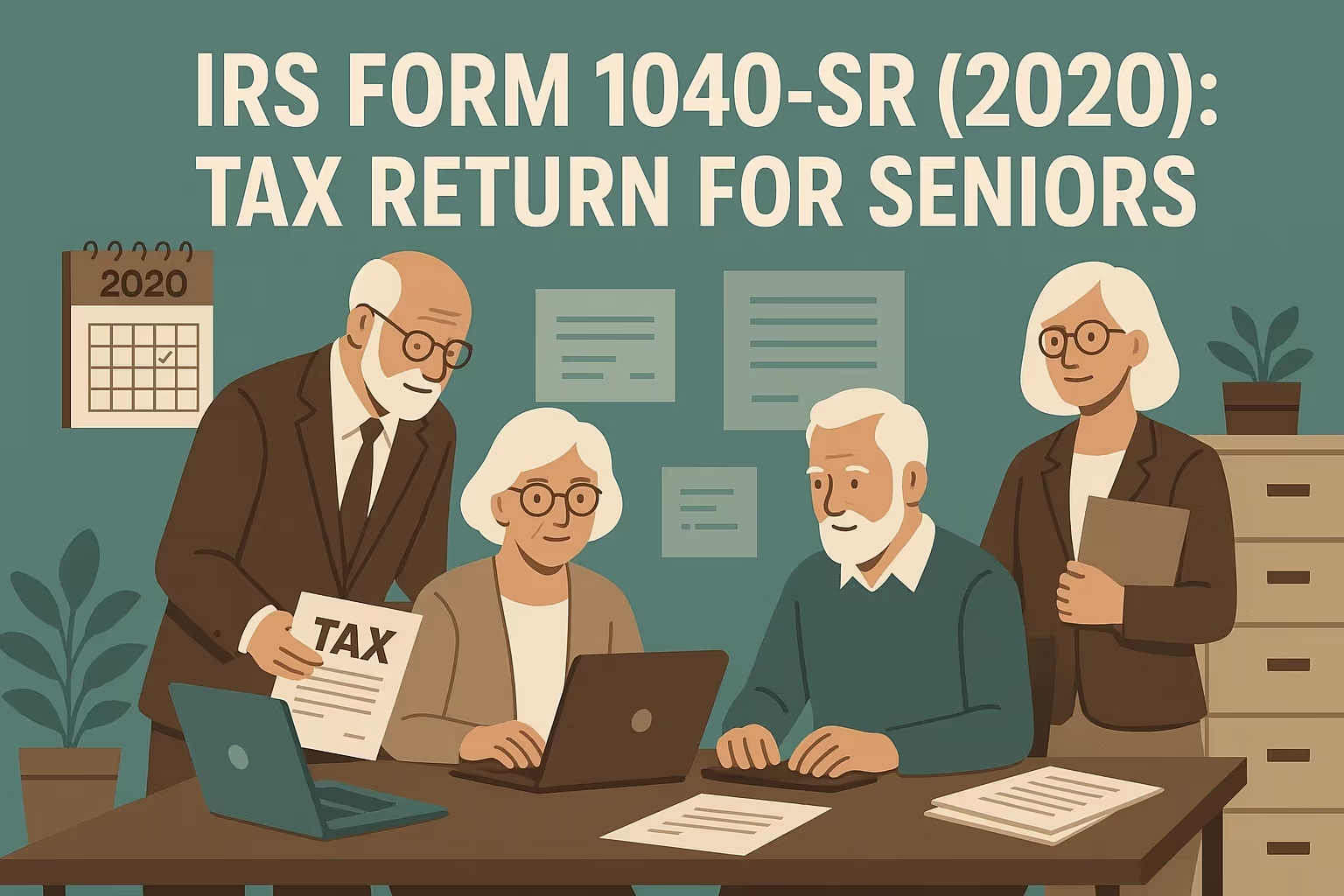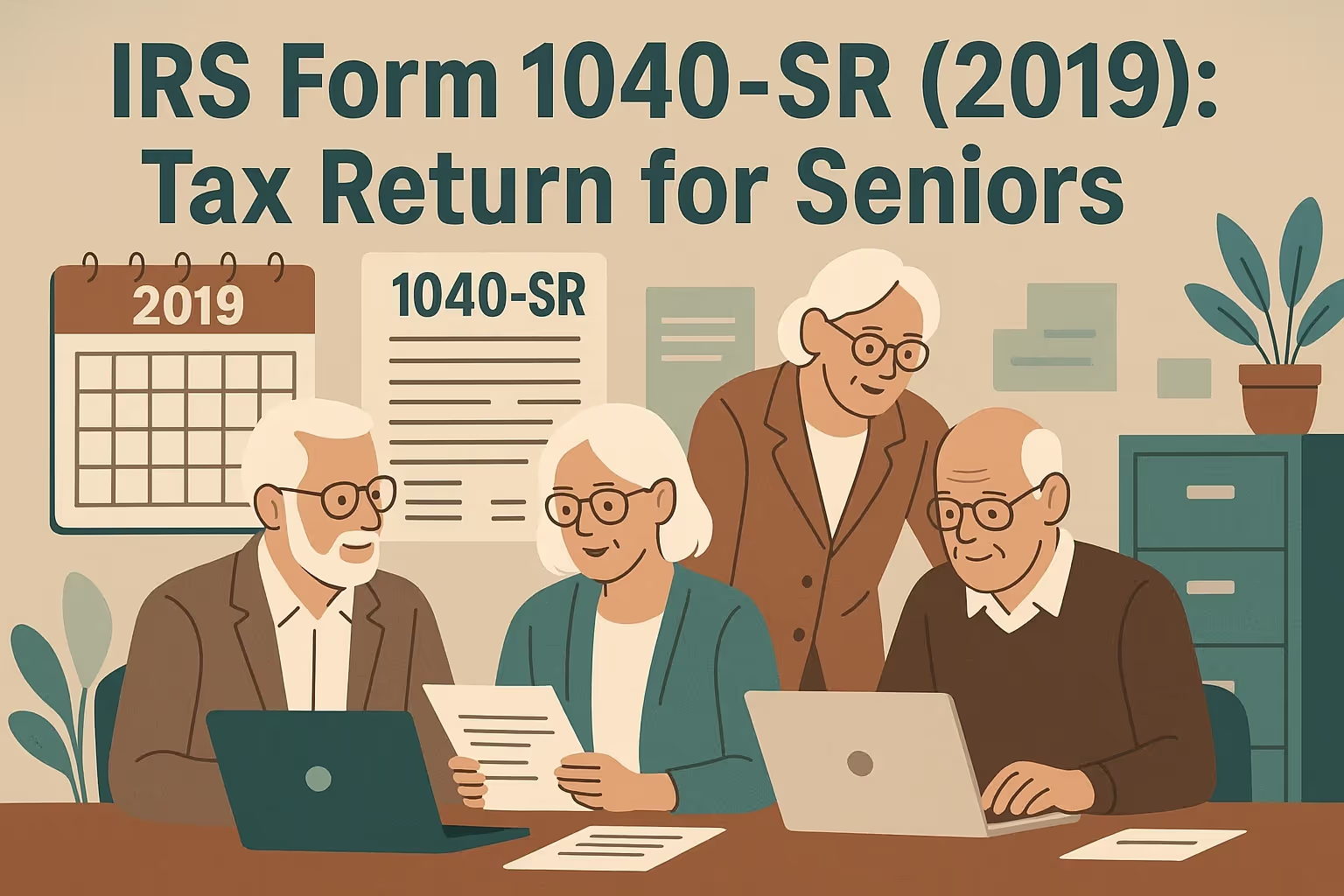Form 1040SR 2021 Instructions: Complete Guide for Seniors
Filing a federal tax return can be challenging, particularly for seniors who must balance retirement income, Social Security, and new financial considerations. To make this process more manageable, the IRS introduced Form 1040-SR, a senior-friendly version of the standard Form 1040. Designed for taxpayers 65 and older, it uses larger print, simplified formatting, and built-in reminders to help older adults complete their returns with greater ease and accuracy.
Several updates affect how seniors prepare their federal tax forms for the 2021 tax year. Standard deduction amounts increased, rules for IRA contributions and Required Minimum Distributions (RMDs) changed, and new credits—like the Recovery Rebate Credit—may apply. This guide explains these changes in plain language, helping you understand how each adjustment impacts your income tax return and overall filing process.
In this step-by-step guide, you’ll find clear Form 1040SR 2021 instructions, from choosing your filing status to reporting income, claiming deductions, and submitting your return. Each section includes practical tips, checklists, and IRS references (including Publication 554: Tax Guide for Seniors) to help you file accurately and on time. Whether you’re filing electronically or by mail, this guide ensures you feel confident as you prepare your 2021 tax return.
Understanding Federal Form 1040-SR
Filing taxes can be more complex for seniors, especially when income comes from pensions, retirement benefits, or Social Security. Form 1040-SR was created to make this process more straightforward. It follows the same rules as the standard Form 1040 but features a more concise layout that confidently helps older adults complete their federal tax forms.
What Is Form 1040-SR?
Form 1040-SR, officially titled U.S. Tax Return for Seniors, is a version of Form 1040 designed for taxpayers 65 and older. It allows older adults to use the exact schedules, deductions, and credits available to all taxpayers. Its design focuses on readability and accessibility.
Key features include:
- Larger print and more straightforward layout: The text and numbers appear in a bold, easy-to-read font that reduces eye strain.
- Simplified formatting: The form mirrors the standard 1040 but includes wider spacing and organized sections to reduce clutter.
- Built-in standard deduction chart: This section lists higher deduction amounts available for taxpayers aged 65 or older or those who are blind.
- Consistent eligibility and reporting rules: The same income, deduction, and credit standards apply to the regular Form 1040.
These features simplify tax preparation for seniors who prefer paper filing or want a clearer view of their financial information. For detailed guidance, refer to the About Form 1040-SR page on IRS.gov.
Who Should Use Form 1040-SR?
Taxpayers 65 or older by the end of the tax year are eligible to file Form 1040-SR. For 2021, this includes anyone born before January 2, 1957. This version of the form is appropriate for:
- Retirees who receive pensions, annuities, or investment income. These taxpayers benefit from the form’s larger print and more straightforward layout, simplifying income reporting.
- Older adults who collect Social Security benefits or earn part-time wages. The structure of Form 1040-SR makes it easier to include various income types while maintaining accuracy.
- Taxpayers who prefer a simple and easy-to-read format for filing their federal tax forms. The design supports clarity and accessibility without changing any tax rules.
Seniors who use tax preparation software or prefer online filing may still choose the standard Form 1040, which includes the exact schedules, deductions, and credits for claiming full federal tax benefits.
What’s New for Tax Year 2021
Several updates in the 2021 tax year affect how seniors complete Form 1040-SR. These changes include higher deduction amounts, revised credit eligibility, and adjustments to retirement account rules. Understanding each update helps older adults file accurately and claim every tax benefit.
1. Higher Standard Deduction Amounts
The standard deduction increased across all filing statuses for 2021. Seniors benefit from additional deduction amounts based on age or blindness.
- Single or Head of Household: An extra $1,700 is available for those aged 65 or older.
- Married Filing Jointly or Separately: An extra $1,350 is available for each qualifying spouse age 65 or older.
These increases can lower taxable income and may reduce total taxes owed.
2. Expanded Earned Income Credit (EIC)
The Earned Income Credit expanded in 2021, allowing more older adults with part-time work or modest wages to qualify. The maximum income limits rose, providing greater relief for those earning income after retirement. Seniors who previously did not meet the age or income thresholds may now be eligible for this credit.
3. IRA and Required Minimum Distribution (RMD) Updates
The age cap for traditional IRA contributions was removed, allowing taxpayers of any age to contribute as long as they have earned income. In addition, the RMD starting age increased to 72, giving retirees more time before withdrawing funds from retirement accounts. These updates offer seniors greater flexibility in managing their retirement income.
4. Recovery Rebate Credit
Seniors who did not receive the full amount of their Economic Impact Payments during 2020 or 2021 can claim the Recovery Rebate Credit on their 2021 return. This refundable credit ensures eligible taxpayers receive the complete stimulus payment amount based on their final income and filing status.
Step-by-Step Filing Instructions
These Form 1040SR 2021 instructions follow the same lines and schedules as the standard Form 1040. The steps below use clear actions and short sentences so older adults can prepare an accurate tax return without confusion.
Step 1 – Choose Filing Status
- Single applies when the taxpayer was unmarried or legally separated on the last day of the year.
- Married Filing Jointly applies when spouses combine income, deductions, and credits on one return.
- Married Filing Separately applies when each spouse files an individual federal return.
- Head of Household applies when the taxpayer was unmarried and paid more than half the cost of a qualifying person’s home.
- Qualifying Widow(er) applies for up to two years after a spouse’s death when a dependent child lived with the taxpayer.
Step 2 – Enter Personal Information
- The return should list legal names, Social Security numbers, and the current mailing address exactly as they appear on official records.
- The age 65 box and the blindness box should be checked where applicable because these selections increase the standard deduction.
- Dependents with full names, Social Security numbers, and qualifying relationships should be listed to support credits and correct filing status.
- The presidential election fund checkbox may be marked or left blank since it does not change the tax owed or refund.
Step 3 – Report Income
- Wages, salaries, and tips should be entered from all Forms W-2, and copies of each W-2 should be attached.
- Taxable interest should be reported, and Schedule B should be included when the total taxable interest exceeds $1,500.
- Ordinary and qualified dividends should be reported from Forms 1099-DIV, with Schedule B added when required.
- IRA distributions should be reported with the taxable portion calculated; Form 8606 should be filed when nondeductible contributions exist.
- Pensions and annuities should be entered with the taxable amount determined using the worksheets in the instructions.
- Social Security benefits should be reported using the worksheet because taxability depends on combined income and filing status.
- Capital gains and losses should be reported on Schedule D when securities or other capital assets are sold.
- Other income from Schedule 1 should be included, which can cover unemployment compensation, state tax refunds, hobby income, virtual currency dispositions, business income, and other items.
Step 4 – Adjustments and Deductions
- Adjustments from Schedule 1 should be entered, including the student loan interest deduction, the deductible part of self-employment tax, traditional IRA deductions, and Health Savings Account deductions.
- Adjusted Gross Income (AGI) should be calculated because AGI affects income limits for many deductions and credits.
- The standard deduction should be compared with itemized deductions because seniors often benefit from the higher age-based amounts.
- Itemized deductions on Schedule A may be worthwhile when medical expenses above 7.5% of AGI, mortgage interest, state and local taxes (subject to limits), and charitable gifts exceed the standard deduction.
- Cash charitable contributions by standard deduction filers may be deductible above the line within the 2021 limits.
- The Qualified Business Income deduction should be calculated on Form 8995 or 8995-A when eligible business income exists.
Step 5 – Calculate Tax and Credits
- Tax should be computed using the Tax Table or the Tax Computation Worksheet, depending on taxable income.
- Schedule 2 should also include a review of additional taxes, including the Alternative Minimum Tax and the net investment income tax, where applicable.
- Nonrefundable and refundable credits should be entered from Schedule 3, including education credits and the retirement savers credit.
- The Credit for the Elderly or Disabled on Schedule R should be evaluated because qualifying seniors may reduce their tax.
- The Earned Income Credit should be checked because the 2021 rules expanded eligibility for certain filers with wages.
- The Recovery Rebate Credit should be claimed when stimulus amounts received were less than the final 2021 entitlement.
Step 6 – Payments, Refunds, and Direct Deposit
- Federal income tax withheld from Forms W-2 and 1099 should be totaled and entered on the payments lines.
- Estimated tax payments and any amount applied from the prior year should be included to reduce underpayment risk.
- The refund should be sent by direct deposit, with accurate routing and account numbers entered to speed up payment.
- Any balance due should be paid by the filing deadline to limit penalties and interest, using the payment options described later in this guide.
- Refund status can be checked after e-file acceptance or mailing using the tools referenced in the resources section.
How to File Your 2021 Tax Return
Form 1040-SR follows the same rules and schedules as Form 1040, so these Form 1040-SR 2021 instructions apply whether the return is filed electronically or on paper. Choose the method that matches access to technology, preference for paper records, and comfort with tax prep software.
Electronic filing (E-file)
E-filing speeds processing and reduces common math mistakes. It supports all required attachments for federal tax forms and confirms receipt.
- E-file typically delivers refunds faster when accurate direct deposit details are included.
- Reputable tax prep software flags missing entries, inconsistent totals, and invalid Social Security numbers.
- E-file supports every schedule needed for additional income, capital gains, and virtual currency transactions.
- Digital PDFs and electronic signatures help older adults organize prior-year documents and prepare a clean tax return file set.
Paper filing
Paper filing suits filers who prefer hard copies or lack reliable internet. It requires careful transcription, complete attachments, and the correct mailing address.
- Current-year Form 1040-SR (2021) and instructions should be used to avoid applying outdated rules.
- Entries should be printed clearly in black or blue ink, and figures should match Forms W-2, 1099-R, 1099-INT, and 1099-DIV.
- All required schedules should be attached, including Schedule 1 for additional income and adjustments, Schedule B for interest and dividends, and Schedule D for capital gains.
Deadlines and extensions
Timing affects penalties, interest, and refund speed. Filing on time and paying any balance due by the original due date helps avoid notices.
- The regular filing deadline for 2021 returns was April 18, 2022, and the extension deadline was October 17, 2022.
- An approved extension extended the time to file but did not extend the time to pay the 2021 income tax owed.
- Any balance due should be paid by the April deadline to limit penalties and interest, regardless of filing method.
If You Owe Taxes: Payment Options
A balance due can arise even after accurate filing. These Form 1040 SR 2021 instructions outline safe ways to pay federal income tax and avoid unnecessary penalties and interest.
- IRS Direct Pay: This free option withdraws a payment directly from a checking or savings account and provides immediate confirmation.
- Electronic Federal Tax Payment System (EFTPS): This government system allows scheduled payments and a full payment history after enrollment.
- Debit or credit card: Third-party processors accept card payments online or by phone and charge convenience fees for the service.
- Check or money order: Mailed payments should include Form 1040-V, the taxpayer’s Social Security number, and the tax year on the memo line.
- Payment plans: Short-term plans cover up to 120 days, while monthly installment agreements spread payments over a longer period.
Payment timing affects cost. Penalties and interest start after the original due date, even when an extension to file was granted. Partial payments reduce interest, so sending any affordable amount is better than waiting for the full balance. Bank account details should be verified before submission to prevent delays.
Visit the IRS Payments page (IRS.gov) for methods, eligibility, and application steps. This resource explains how to set up Direct Pay, EFTPS enrollment, card processors, and installment agreements.
Required Schedules and Attachments
Form 1040-SR uses the exact schedules as Form 1040, but with a bigger print layout that is easier to read. Accurate schedules and supporting forms ensure the result matches IRS records for the 2021 tax year. Copies from previous years often help verify totals and identify missing documents before schedules are filled and signed.
- Schedule 1 – Additional income and adjustments: This schedule reports business income, unemployment compensation, and K-1 items, including partnership statements issued under Bipartisan Budget Act rules.
- Schedule B—Interest and dividends: This includes the foreign account question, which asks whether the filer had a financial interest in or signature authority over a non-U.S. account.
- Schedule D – Capital gains and losses: This schedule reports sales of investments and any like-kind exchange reported on Form 8824, when applicable to real property.
- Schedule A – Itemized deductions: This schedule may apply when medical expenses, taxes, mortgage interest, or gifts exceed the standard deduction for seniors.
- Schedule R – Credit for the Elderly or Disabled: This schedule may reduce tax when income and filing status meet eligibility limits.
- Schedules 2 and 3—Additional taxes, credits, and payments: These schedules capture AMT, net investment income tax, education credits, and other taxes.
Attachments should include Forms W-2, 1099-R, 1099-INT, 1099-DIV, SSA-1099, and any K-1s. The IRS may request additional statements or worksheets, so organized records support faster processing and accurate tax return totals.
Common Mistakes to Avoid
Minor errors can delay refunds or increase what a taxpayer owes. The points below highlight frequent issues for seniors filing Form 1040-SR and explain simple checks that prevent problems before submission.
Income tax calculation errors
Many mistakes happen when numbers move from worksheets to the return. Compare figures to source forms and confirm higher age-based standard deduction eligibility.
- The age-65 checkbox is sometimes missed, which reduces the allowable standard deduction.
- Social Security taxability is often miscalculated; the worksheet must determine the taxable portion.
- Form 8606 is required when nondeductible IRA contributions exist; failing to file it can cause double taxation.
- Bank routing and account numbers are occasionally entered incorrectly, delaying refunds or misdirecting payments.
Reporting additional income correctly
Schedule 1 captures many items that do not appear on the main form. Review this schedule carefully to avoid missing income or adjustments.
- Side-business earnings, unemployment compensation, and taxable state refunds belong on Schedule 1 when applicable.
- Digital asset sales must be reported when dispositions occur; unrealized holdings are not reported.
- Capital gains should match Forms 1099-B and any basis adjustments to prevent CP2000 notices.
- Pension and annuity amounts must be divided between gross and taxable using the proper worksheets.
Accurate identification and complete attachments support smooth processing. Ensure Social Security numbers match federal records, attach required forms such as W-2, 1099-R, 1099-INT, and 1099-DIV, and sign and date the return. Retain copies of the signed returns and confirmations to support future amendments or correspondence.
Filing with Minimal or No Income
Some seniors have limited activity in a given year, yet a filing requirement can still apply. The rule depends on gross income, filing status, and age. Social Security alone is often not taxable, but other income sources can change the outcome. Compare gross income to the 2021 thresholds before preparing a Form 1040-SR tax return.
2021 filing thresholds for seniors
- Age Condition: 65 or older
- 2021 Filing Threshold: $14,250
- Age Condition: Both spouses 65+
- 2021 Filing Threshold: $27,800
- Age Condition: One spouse 65+
- 2021 Filing Threshold: $26,450
- Age Condition: 65 or older
- 2021 Filing Threshold: $20,500
- Age Condition: 65 or older
- 2021 Filing Threshold: $26,450
- Age Condition: Any age
- 2021 Filing Threshold: $5
When filing still helps below thresholds
- Refund recovery: Filing can return federal income tax withheld from wages, pensions, or annuities.
- Credits: A return may secure refundable amounts, such as the Recovery Rebate Credit and, in limited cases, the Earned Income Credit.
- Recordkeeping: A filed return documents income and supports corrections to previous years if circumstances change.
- State rules: A state income tax return may be required even when no federal filing is necessary.
Even when no federal return is required, filing can return withheld tax, claim refundable credits, and create a clear record for future amendments. A quick review of state filing rules and potential refunds helps determine whether submitting a 2021 Form 1040-SR is worthwhile. This simple step prevents missed refunds and eases future correspondence.
First-Time Senior Filers
Many seniors file a federal tax return for the first time after new milestones—starting pension or IRA withdrawals, receiving taxable Social Security, returning to part-time work, or a status change after a spouse’s death.
Form 1040-SR follows the same rules as Form 1040 but uses a more straightforward layout that supports readability. Understanding what triggers a filing requirement and how income is reported reduces avoidable notices and penalties.
- Documents: First-time filers should gather Forms W-2, 1099-R, 1099-INT, 1099-DIV, SSA-1099, any 1099-B, and 1095-A, plus last year’s return, ID, and bank details.
- Timing: To prevent corrections and delays, filing should begin after all statements arrive, typically by early February.
- Filing method: Many choose reputable tax prep software to e-file, while VITA or TCE sites provide free in-person help; paper filing remains available.
- After filing: Signed copies, e-file acknowledgments, and direct-deposit details should be saved, and filers who owe tax should consider quarterly estimated payments.
Frequently Asked Questions (FAQs)
Do I have to use Form 1040-SR if I’m 65 or older?
Form 1040-SR is optional. Taxpayers 65 or older may file either Form 1040-SR or the standard Form 1040. Both use the same lines, schedules, credits, and calculations. The SR version provides larger print and a more straightforward layout. Many seniors choose 1040-SR for readability, while software users often keep Form 1040 and get the same result.
Can my spouse and I use Form 1040-SR if only one of us is 65?
Yes, if either spouse is 65 or older at year-end, a joint return may use Form 1040-SR. Filing status, income reporting, deductions, and credits remain identical to Form 1040. Couples can choose whichever layout they prefer. When e-filing, the underlying return follows Form 1040 rules even if the printed copy mirrors 1040-SR formatting.
Are Social Security benefits always taxable?
Social Security benefits are not always taxable. Taxability depends on “combined income” (AGI plus nontaxable interest plus one-half of benefits). For single filers, benefits become taxable when combined income exceeds $25,000; for married filing jointly, the threshold is $32,000. Up to 85% of benefits may be taxable. The worksheet in the instructions determines the exact taxable amount for the return.
What is the higher standard deduction for seniors in 2021?
Seniors receive an additional standard deduction for 2021. The extra amount is $1,700 for Single or Head of Household filers, and $1,350 for each spouse age 65 or older on a joint or separate return. Those who are blind may claim an additional equal amount. Remember to check the age and blindness boxes to receive the higher deduction.
How do I claim the Credit for the Elderly or Disabled?
Claim the credit by filing Schedule R with Form 1040-SR. Eligibility generally requires being 65 or older, or under 65 and permanently disabled with taxable disability income. Income must be below limits shown in the instructions (for 2021: Single $17,500; MFJ both qualifying $25,000; MFJ one qualifying $20,000; MFS $12,500). The credit reduces tax but is nonrefundable.


















